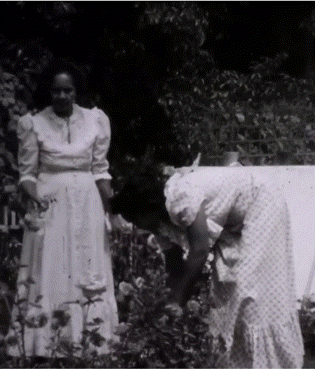Unearthing Joy & Liberation in Oakland’s Black Foodways
This is the first part of the ongoing series, Black Food, Love + Liberation, curated by our Digital Culture Fellow, Ugoada Ikoro. In this weekly series, Ugo will capture stories of joy, beauty, community care, and thriving (beyond surviving) hidden beneath mainstream narratives shaping Black foodways and our relationships to the land. This month’s theme? Unearthing Liberatory Black Foodways in Oakland, CA.
African American Museum & Library at Oakland . “Men and Women Talking at Backyard Garden Party,” Towns (Royal E.) Papers, 1970.
In the warm light of an early spring morning, I look upon weathered raised beds in the backyard garden of my home in the unceded Lisjan territory of West Oakland. These beds were built long before I arrived, and as I prep for spring and summer planting, I’m reflecting on what previous families grew and how they tended to their kin with nourishment from this soil.
The quiet communal garden tells the tale of food traditions rooted deep within the grooves of these splintered wooden frames, filled with earth that will hold the seeds I sow and tend to in the warmer months with my housemates and neighbors...
Video of 2 women picking flowers in a garden circa 1950. Clipped from the Ernest Bean Home Movie 16mm Reel 4 circa 1950s, African American Museum & Library at Oakland.
I'm soaking in what it means to resist the oppression and erasure of our Black foodways. What might these tiny scaffolds of earth scattered throughout West Oakland’s neighborhoods tell us about the lived traditions, cultures, and historical and contemporary narratives of Black foodways in North America?
What were Black Oakland residents growing in their backyards during the Jim Crow and Civil Rights eras, and how were they feeding their communities? What did expressions of joy, play, and meal-sharing look like within their families?
African American Museum & Library at Oakland . “Men and Women Talking at Backyard Garden Party,” Towns (Royal E.) Papers, 1970.
Throughout the early and mid-20th century, much of Oakland's Black working class lived in "garden living" neighborhoods—with homes featuring yards or garden spaces for families to grow and tend to one’s vegetable and livestock after a long day of work in maritime, at the mill or in automotive factories. These communities were typically located in intentionally designated transit-friendly areas that connected the working class to the infamous tributary, the San Francisco Bay.
On any given day, you might catch a glimpse of folks breaking bread in their manicured backyard gardens, sharing plates of food made from ingredients grown right there, adorned in dresses and hemmed skirts sewn by the local seamstress, and enjoying the sun while they left their children with caretakers for the day.
These images encompass peace, celebratory thriving, and joy—themes I am interested in taking up in this newsletter and beyond my fellowship with Food Culture Collective. These images tell the story of sovereign, liberated Black people expressing what it means to craft nourishing foodways, supplanting dominant narratives of displacement, extraction, and erasure.
“I’m soaking in what it means to resist the oppression and erasure of our Black foodways.”
Through historic archival images, oral histories, and stories, this series will continue to unearth the themes showcased here—profound mutuality, care, and belonging amidst uncertainty and codified separation.
About the author
Ugo is a storyteller, food & public health justice advocate, and land steward. During the 6-month Digital Culture Fellowship, she'll be exploring her foodways and how systems of oppression have shaped the ways Black people engage with food culture in the US and across the Diaspora. Through tending to the land, discovering the practices of her ancestral lineage, and finding inspiration in the stories and legacies of Black land predecessors and successors, Ugo is bridging gaps in how we tell stories about our connections to the Earth and each other.
Want to keep up with this series? Be sure to subscribe to our newsletter to get Ugo’s explorations straight to your inbox!
Digging Deeper
Interested in digging into the deeper context of housing land access in the Bay Area during the mid-20th century? Check out further readings below:
Oakland: Redlining and Demographics— Check out Segregation by Design’s mapping and brief outlining the relationship between residential segregation and race in Oakland, CA.
“Urban and rural modes of survival came together here, as workers clocked out and headed home to tend vegetables, chickens, and goats in their yards.” Nathan McClintock’s “From Industrial Gardens to Food Deserts”, published in Cultivating Food Justice, dives into the juicer details surrounding food disparities and its relationship to the ongoing legacy Jim Crow residential divide in the Bay Area.




